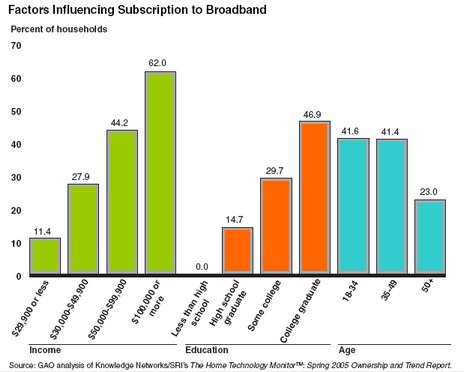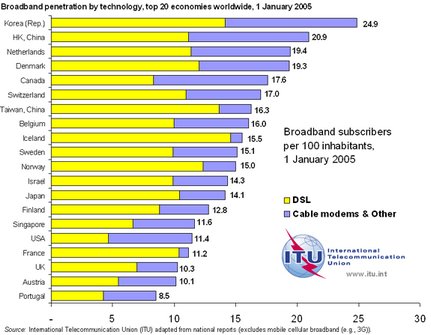
Page 2/9 |
What is broadband?
Broadband is a term you may be hearing a lot about lately. Broadband is shorthand for any type of high-speed Internet access. The FCC's definition of broadband is any system capable of transmitting data in excess of 200 Kbps upstream and downstream.
Communication systems that operate at a slower speed than broadband are called "narrowband." Usually consumers associate DSL and cable modems with broadband and dial-up services with narrowband.
Access to broadband opens up many possibilities such as voice services, high-speed data services, video services, and interactive information delivery services. These services can change how communities connect to each other, work, process information, and provide services.
Broadband technologies fall into two categories; wired and wireless. Wired technologies include cable, DSL, fiber and broadband over powerline. Wireless technologies include fixed wireless, satellites, wi-fi and wi-max.
Broadband in the USABroadband is such an essential part of the telecommunications infrastructure and is considered a national priority.
For most of urban centers and suburban communities, this goal has already been achieved. Unfortunately, broadband deployment in rural America lags behind the rest of the country. Accurate statistics on broadband availability in rural areas are sorely lacking, but there is no doubt that broadband options are more limited and more costly in many rural areas.
According to the Government Accounting Office (GAO) factors influencing broadband deployment include:
- the population in the area;
- the population density in the area;
- the percentage of the population residing in an urban area;
- the per capita income in the area;
- the educational attainment of the population in the area;
- the population teleworking in the area; the age of the population in the area;
- the distance to a metropolitan area with a population of 250,000 or more; and
- whether the state in which the area is located imposed a tax on Internet access in 2005.
Factors influencing broadband adoption include:
- the income of the household;
- the education attainment of the heads of the household;
- the age of the heads of the household;
- the presence of children in the household;
- the racial composition of the household;
- the occupation of the heads of the household;
- the number of people in the household;
- whether the household resides in an urban, suburban, or rural location;
- the number of companies providing broadband service in the area; and
- whether the state in which the household resides imposes a tax on Internet access.

Source: "Telecommunications: Broadband Deployment Is Extensive throughout the United States, but It Is Difficult to Assess the Extent of Deployment Gaps in Rural Areas," GAO-06-426, May 5, 2006
Rural communities need to make broadband access a priority for homes and businesses. The same GAO report found:
We also found that strong leadership within a community can help promote broadband deployment by, for example, enhancing the likely market success of companies' entry into rural markets.
Other Considerations For Comparing Types of Delivery
Price vs. SpeedAfter determining what types of connections are available it can still be confusing to select a delivery method. Despite the confusing options, acronyms, technical terms, and statistics, the choice simply boils down to two criteria: price and speed. Generally speaking, faster connections correspond with higher bills. Before making any final decision about broadband options, it is important to consider how you or your organization will be using the Internet.
A Broadband Comparison of Download Speeds
SymmetryWhen thinking about delivery methods for Internet it is important to think about available speeds for downloading and uploading. Most services are asymmetrical meaning they offer faster download speeds than upload speeds. This model made sense when most users were heavy downloaders. Those patterns are changing and many users and businesses are demanding higher upload speeds.
How Does the U.S. Compare?From the previous section you saw several comparisons of broadband in terms of price and speed. It is important to realize that definitions of what constitutes broadband differ around the world. In general people in the United States pay more for slower speeds. The following is another way to think about broadband differences.
This chart comes from the International Telecommunications Union an international organization within the United Nations responsible for coordinating global telecom networks and services. This chart is simply showing which countries have the most broadband subscribers per 100 inhabitants as of January 2005. This chart shows that the United States ranks 16 th , a huge decline from being 4 th in 2000. This speaks to the importance of federal polices.
The chart is also from the International Telecommunications Union (ITU). The purpose of this chart is to show that different countries have different expectations for broadband speeds as well as different prices charged per kilobit per second. Japan offers the most megabits for the dollar whereas the United States is lagging not only in broadband penetration but also in available speeds and affordability. In order for the United States to compete in a global economy availability as well as price and speed need to be considered by top policy makers.
The ITU also pointed out that countries that lowered their prices also have higher broadband penetration. The United States could learn from this example and seek to increase broadband availability by offering increased speeds and decreased costs.
Broadband – Expectations Differ
As you can see from these discussions, all broadband is not equal. Not only do we have issues of unequal access within the United States but when considered from a global perspective we can see more inconsistencies. Despite the technology used to deliver service it is clear that different countries define broadband differently.
Page 2/9 |
Web site and all contents © Copyright SRDC 2009, All rights reserved. |
|
| These materials were developed as part of the Southern Rural Development Center’s National e-Commerce Extension Initiative. They are based upon work supported by the Cooperative State Research, Education, and Extension Service, U.S. Department of Agriculture, under Award No. 2005-45064-03212 Any opinions, findings, conclusions, or recommendations expressed in this publication are those of the author(s) and do not necessarily reflect the view of the U.S. Department of Agriculture or the Southern Rural Development Center. |
|

